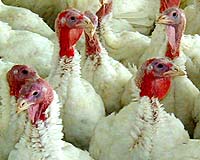| . |  |
. |
Pointe Denis, Gabon (AFP) Nov 27, 2009 After two hours of scouring the beaches of Pongara National Park in the dark night, Joan Ikoun-Ngossa and his patrol finally find a leatherback turtle. It has just laid its eggs and is struggling awkwardly back to the sea. For its young, however, there is just a one in a thousand chance of making it to adulthood, thanks to a deadly combination of humans, natural predators, pollution and sometimes sheer bad luck. With the help of a light -- coloured red, so as not to dazzle or upset the turtle -- Ikoun-Ngossa of Aventures Sans Frontieres (ASF -- Adventures Without Borders) climbs onto the animal to take measurements. It comes in at 1.6 metres (5.2 feet) long and 1.11 metres wide. The leatherback is the world's largest species of turtle -- they can live for up to 80 years and reach 2.4 metres in length. However, it is critically endangered. After measuring the turtle, Ikoun-Ngossa attaches a ring on its back leg to track its progress after it leaves the Gabonese coast. Clumsy and awkward on land, the turtle disappears in a few strokes once it reaches the water, leaving behind great crawl marks in the sand like the tyre tracks of a four-wheel-drive. During the two-month egg-laying season, beginning in October, the turtles scramble onto the beach at night, dig a hole, lay their eggs inside and cover them with sand before departing again. The whole process takes a little less than two hours. The females lay between 50 and 120 eggs, and one in three is a "dud", with no embryo inside, says Ikoun-Ngossa, a former boatman who now works to protect his country's wildlife. "The dud eggs are part of the nest. They contribute to regulate the airflow and temperature, and no doubt nature probably intended them as a kind of decoy for predators," he says. There is no shortage of predators: monitor lizards, crabs and birds, which are all part of the natural order, but also humans, who sometimes find and eat the eggs, and dogs which dig them up. "Of a thousand eggs laid, we estimate that only one will survive to become an adult turtle," said Angela Formia of the Wildlife Conservation Society. Ikoun-Ngossa stays on the Pongara beaches from October to April to try to improve the eggs' chances of survival. "If the turtle lays below the waterline, the eggs have no chance so we take those ones and put them in a special enclosure" further up the beach, he said. This makeshift "maternity ward" is currently host to more than 300 eggs. After two or three months, the eggs hatch and the baby turtles, just a few centimetres long, crawl toward the sea, where many are eaten by birds, sharks and other predators. "Currently there are around 40,000 females which come to Gabon, and this is the largest leatherback turtle population in the world," Formia said. Females lay their eggs every two or three years, Ikoun-Ngossa explains, and study of the tracking devices has shown one turtle can lay up to three batches of eggs in ten days before swimming off again. Knowledge of the turtles' lives outside these laying periods is limited. "The data shows they move to the cold waters in the middle of the Atlantic and to the south," Formia said. "A number have been recorded off the coast of Brazil and Argentina." Leatherback turtles play a big role in traditional Gabonese stories. Legend has it they overcame leopards, snakes and crocodiles through their cunning. Today, many observers believe the leatherback turtle is facing extinction unless more is done to safeguard their welfare. They say the biggest threat to their survival comes not from predators but from man-made pollution, in particular plastic bags which turtles mistake for jellyfish -- their main diet.
Share This Article With Planet Earth
Related Links Darwin Today At TerraDaily.com
 Scientists to complete turkey genetic map
Scientists to complete turkey genetic mapBlacksburg, Va. (UPI) Nov 26, 2009 U.S. scientists have secured funding to complete the genetic map of the North American domesticated turkey adorning millions of U.S. dinner tables Thursday. The Turkey Genome Sequencing Consortium -- made up of Virginia Polytechnic Institute and State University researchers working with the University of Minnesota, the University of Maryland and the U.S. Department of Agriculture ... read more |
|
| The content herein, unless otherwise known to be public domain, are Copyright 1995-2009 - SpaceDaily. AFP and UPI Wire Stories are copyright Agence France-Presse and United Press International. ESA Portal Reports are copyright European Space Agency. All NASA sourced material is public domain. Additional copyrights may apply in whole or part to other bona fide parties. Advertising does not imply endorsement,agreement or approval of any opinions, statements or information provided by SpaceDaily on any Web page published or hosted by SpaceDaily. Privacy Statement |